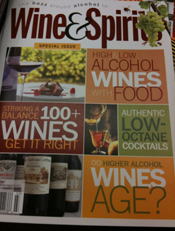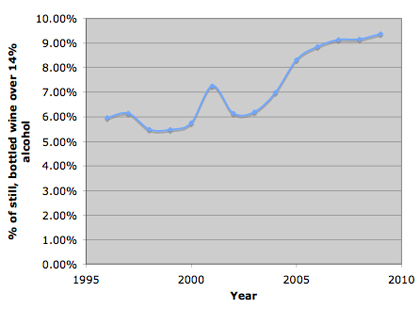Wine, alcohol, and tax – in Wine & Spirits magazine
 How often is the alcohol level stated on the label consistent with what is actually in the bottle?
How often is the alcohol level stated on the label consistent with what is actually in the bottle?
Wines are allowed a certain fudge factor between what appears on the label and what is actually in the bottle. For wines under 14%, the wine can fluctuate by 1.5 percentage points, which explains why so many wines have traditionally been labeled 12.5% since that gave the maximum flexibility. Above 14%, the producer must pay a higher tax ($1.57 per gallon as opposed to $1.07 for the lower level) and the allowable wiggle room shrinks to one percentage point deviation from what’s stated on the label.
I was curious how often consumers get what they think they are getting. To gain some idea, I oversaw the analysis of a random sampling of 80 wines from the offices of Wine & Spirits magazine, half foreign and half domestic wines. Although we treat the findings as anecdotal, it was interesting to note that half the wines we sampled were almost spot on the stated level, deviating only 0.3 percentage points from the stated level. However, a full ten percent of the wines tested were in the wrong tax bracket, that is to say, they were steering the consumer quite wrong as well as costing the Treasury revenue.
There’s also a perception that wines north of 14% have become more prevalent. In order to determine the extent of this, I examined reports from the Treasury’s TTB unit, which regulates the alcohol industry. Their data showed that wines over 14% alcohol comprised six percent of the still, bottled wines in America in 1995. By 2009, these higher alcohol wines had risen by 50% to account for nine percent of still, bottled wines.
The TTB is in the first year of a market compliance study, examining wines randomly sampled from the retail shelves around the country. The results of this study will be available next year. The TTB currently has 14 investigators nationally involved in enforcement and inspection; There are over 6,500 wineries now in the United States.
Be sure to check out the current issue of Wine & Spirits for my full story. The issue is entirely dedicated to “the buzz around alcohol” and has articles by David Schildknecht, Jamie Goode, Fiona Morrison and others.
UPDATE: The article is now available on the Wine & Spirits site.





On August 24th, 2010 at 7:51 am ,TuomasMW (Tuomas Meriluoto MW) wrote:
Twitter Comment
Wine, alcohol, and tax – in Wine & Spirits magazine | Dr Vino’s wine blog [link to post] #wine @drvino
– Posted using Chat Catcher
On August 24th, 2010 at 8:59 am ,1WineDude wrote:
Wow – that chart isn’t surprising but for some reason I am still kind of shocked to see it. How many wines are represented in those reports?
On August 24th, 2010 at 9:28 am ,maggiejane (Maggie Hoffman) wrote:
Twitter Comment
RT @makerstable in Wine & Spirits article by @drvino: Notable: percentage of wines >14%VAC: 1995 = 6%; 2009 = 9% [link to post]
– Posted using Chat Catcher
On August 24th, 2010 at 10:01 am ,makerstable (Meg Houston Maker) wrote:
Twitter Comment
Wine, alcohol, and tax: Wine & Spirits Mag by @drvino: Notable: percentage of wines >14%VAC: 1995 = 6%; 2009 = 9% [link to post]
– Posted using Chat Catcher
On August 24th, 2010 at 10:54 am ,alaingles (Alain Ingles) wrote:
Twitter Comment
How often is the alcohol level on the label consistent with what is in the bottle? | RT @drvino: Wine, alcohol, and tax [link to post]
– Posted using Chat Catcher
On August 24th, 2010 at 11:02 am ,Mike Veseth wrote:
It is a great article, Tyler. Nice work. Can you answer a question about the wines that were tested? As I recall, the French wines were mainly from Burgundy with nothing from Bordeaux. Was that done on purpose? Bordeaux is where I would expect the alcohol to show up more than Burgundy. It seems like comparing Napa with Bordeaux would be interesting.
Best,
Mike
On August 24th, 2010 at 1:05 pm ,Jon Bjork wrote:
This data makes sense to me. I doubt you’ll see the percentage of wines over 14% alc by vol increasing much more, simply because the majority of wine is produced for the mass market where the consumer is more interested in smoothness and sweetness with little sharpness in the wines. That would allow the large wineries to keep alcohol levels down under the 14% tax cut off.
I think we’ve been seeing the rise in alcohols more on wines from boutique wineries that are more sensitive to critics’ scores and a quest for ripeness.
Note that most boutique wineries can take full advantage of the TTB’s Small Producer’s Tax Credit, which saves 90 cents per gallon, driving the taxes down to only $0.17/gal for under 14% and $0.67/gal for over 14%.
Wineries also usually have to pay excise taxes to their home state. In California all wineries pay $0.20 per gallon, regardless of tax class. Note that a boutique winery is therefore paying more to California for under 14% wines than to TTB.
And to finish my geekiness… only the first 100,000 gallons removed from bond can receive any Small Producer Credit. Wineries producing over 250,000 gallons per year cannot take this credit.
On August 24th, 2010 at 2:20 pm ,winetonite (Ed Thralls) wrote:
Twitter Comment
Wine, alcohol, and tax in Wine & Spirits magazine [link to post] (via @drvino)
– Posted using Chat Catcher
On August 25th, 2010 at 7:40 am ,Dr. Vino wrote:
@1winedude The TTB tracks wines, bottled and bulk.
@Mike Veseth – We did try to test some hypotheses but also tried to get a somewhat representative sample of the wine marketplace in general, split between foreign and domestic. However, we were limited to the wines the magazine had on hand. Hopefully we can do further tests in the future.
@Jon Bjork- Thanks for mentioning the Small Producer’s Tax Credit and its implications for producers.
Thanks for the interest!
On August 25th, 2010 at 9:23 am ,Lisa Mattson wrote:
Tyler,
Great post. Just got my issue of Wine & Spirits. Looking forward to reading the article.
Best,
Lisa
The Journey of Jordan: a wine and food video blog
On August 25th, 2010 at 11:41 am ,Tom wrote:
Not surprising. The producers of the French wines I import are allowed to round down to the nearest 0.5% on their labels. So if the wine is 13.9 they can put 13.5 on the front label — and as the importer I have to have the same number on my own label. If I ask the producer to remake the front label, it costs a lot of money. Some of them don’t put that information on the front, which is great, but most of them do.
On August 25th, 2010 at 3:42 pm ,evandawson (Evan Dawson) wrote:
Twitter Comment
Should we believe wine alcohol numbers? Great and important work from @drvino. [link to post]
– Posted using Chat Catcher
On August 25th, 2010 at 4:04 pm ,personalwine (personalwine) wrote:
Twitter Comment
@drvino pulls in an awesome blog post “Wine AWESOME, “alcohol” YAY, “TAX” damnit I hate taxes…. [link to post] enjoy
– Posted using Chat Catcher
On August 29th, 2010 at 9:19 pm ,Erika Szymanski wrote:
Does anyone know why the famous fudge factor exists? Alcohol concentration is fast and easy to measure with a good old-fashioned ebulliometer to greater than 1.5% accuracy. Is it to allow for variation within wines bearing the same label? For historical reasons?
On August 30th, 2010 at 10:39 am ,Jon Bjork wrote:
Erika, while it is true that running an alcohol in the lab is quick, the issue is mainly the lead time in printing labels. Many label companies during the busy bottling times of the year can take 6 weeks to print labels. Some require that a TTB Certificate of Label Approval be issued before making the printing plates. The approval process often tacks on another week. During what could be a 7 week period, winemakers may have made last-minute blending tweaks that will have altered the blend.
On March 11th, 2011 at 12:11 pm ,Alan Baker wrote:
Alcohol levels do change over time and vary from barrel to barrel. I recently had tests done to determine alc for inclusion on the label and found a variation in lots that seemed to indicate that the finished wine would be at 14.1% ABV. That is what I put on the labels, and after blending the lots (no other modifications were done other than filtration since it was a white wine) the finished wine in bottle tested at 13.8%
Thus we’ll pay the higher tax rate. It is a small run of 100 cases so the tax hit won’t be huge. I’m a stickler for accuracy in labeling but I can easily see how a big winery would be tempted to shoot on the low side of expectations if they are close to the boundary.
Alan – Cartograph wines
On March 15th, 2011 at 3:27 pm ,Robert McIntosh (@thirstforwine) wrote:
interesting to see the results when they come out. In part this is “caused” by a system that allows a variation of 1.5% … yet then insists on printing numbers in increments of .1%
I’d be particularly interested in the differences between US & EU bottles
On March 15th, 2011 at 3:37 pm ,Robert McIntosh (@thirstforwine) wrote:
… oh, and to @jon bjork – a 1.5% change in alcohol levels in a finished wine is a pretty MAJOR tweak, don’t you think?
it’s all about systems being bent over time to suit the industry (at various levels) rather than the consumer, no?
On March 15th, 2011 at 10:21 pm ,Jon Bjork wrote:
Yes, 1.5% is a pretty major tweak, but remember that broader range is below 14% in the “less hot” zone, where I think most of us are more tolerant anyway.
On May 17th, 2011 at 4:48 pm ,Disposition, acquisitions, dentists and alc levels — sipped & spit | Dr Vino's wine blog wrote:
[…] the results of an extensive story I did for Wine & Spirits magazine is now online. (See our summary discussion.) In the story, we analyzed 84 randomly selected wines for alcohol levels and had some surprising […]